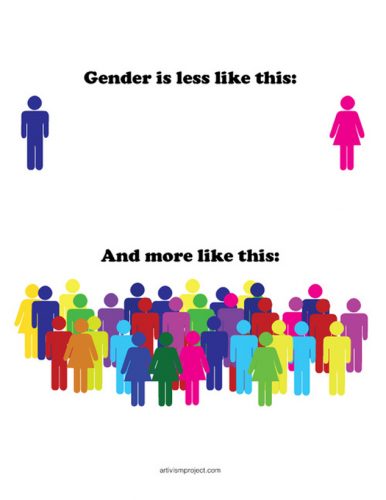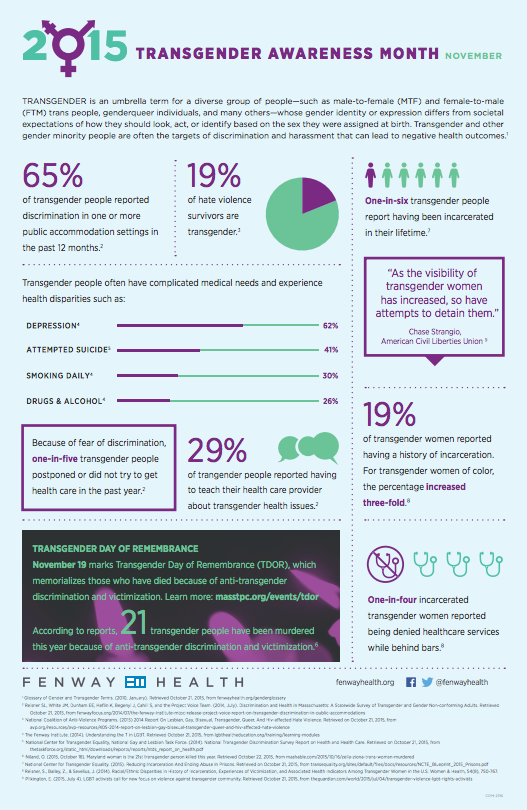Transgender Health

Introduction to Language
Transgender is an umbrella term for a diverse group of people—such as trans women (male-to-female) and trans men (female-to-male), genderqueer individuals, and many others—whose gender identity or expression differs from societal expectations of how they should look, act, or identify based on the sex they were assigned at birth. Transgender and other gender minority people are often the targets of discrimination and harassment that can lead to negative health outcomes.
Here’s a useful tool from our friends at The Safe Zone Project to learn more.
Transgender people face numerous health disparities as well as stigma, discrimination, and lack of access to quality care. Some health disparities include an increased risk of HIV infection, especially among transgender women of color, and lower likelihood of preventive cancer screenings in transgender men. See the graphic below for more information.

There are a number of relatively simple things that can be done in an office to make transgender patients more comfortable:
- Gender-neutral bathrooms
- Leaving a blank space after the question on gender or offering a “transgender” option on intake forms
- Gender-neutral language (such as “partner”) when asking about a patient’s sexual or relationship history
Here’s an inclusive intake form created by the Fenway Institute.
Many transgender people choose to undergo hormone replacement therapy to more closely align their bodies with their identities. Often, a primary care physician and/or endocrinologist manage their care. The World Professional Association for Transgender Health (WPATH) offers up-to-date guidelines.
WPATH guidelines do NOT require that an individual live as the desired sex for a year, nor do they require approval from a mental healthcare professional before undergoing therapy, rather they encourage providers to obtain informed consent before initiating therapy.
For adolescent patients, some may realize they are transgender before or when they are first entering puberty. Under the guidance of a therapist, endocrinologist, adolescent medicine physician, and/or primary care physician these patients may be treated with gonadotropin-releasing hormone (GnRH) analogues, such as leuprolide, that reversibly delay puberty until the patient and parents are ready to make a decision about permanent cross-sex hormones, usually around age 16.
Some transgender people opt to have surgery so that their bodies more fully match their identities, while others do not desire or cannot afford surgery. Both the transgender and medical communities strongly believe that transgender people do not need to undergo gender-affirming surgery to socially transition.
More information about medical and surgical therapy can be found at the Transgender Center for Excellence.
There is much controversy surrounding transgender identity and the field of mental health. At the moment, transgender people often receive medical care under the diagnosis of ‘Gender Dysphoria’ found in the Diagnostic and Statistical Manual of Mental Disorders V, while in the past being diagnosed with ‘Gender Identity Disorder,’ now considered an outdated and incorrect term.
Many people believe that transgender identity is NOT a mental disorder and should be a medical, rather than psychiatric, diagnosis. Some physicians use the diagnosis, ‘endocrine disorder otherwise unspecified,’ to avoid using a psychiatric diagnosis altogether.
Most people recognize that even though transgender identity is truly a medical issue, the social stigma associated with the identity can create a difficult situation for those who identify as transgender. Therefore, many physicians recommend consultation with a mental healthcare professional if the patient so desires.
Fenway Institute Transgender Health
The National LGBT Health Education Center provides educational programs, resources, and consultation to health care organizations with the goal of optimizing quality, cost-effective health care for transgender people.
Transgender Center for Excellence
The goal of the University of California San Francisco Transgender Center for Excellence is to improve the overall health and well-being of transgender individuals by developing and implementing programs in response to community-identified needs. They include community perspectives by actively engaging a national advisory body of 14 transgender identified leaders from throughout the country.
World Professional Association for Transgender Health
The World Professional Association for Transgender Health (WPATH) is a non-profit, interdisciplinary professional and educational organization devoted to transgender health.
GLAAD’s Transgender Health Resources
GLAAD, formerly the Gay and Lesbian Alliance Against Defamation, has broadened their scope to focus on advocating for equality for transgender people. Their resource page contains links to a multitude of support resources, as well as platforms for stories from the transgender community.
Human Rights Campaign’s Transgender Resources
The Human Rights Campaign represents a force of more than 1.5 million members and supporters nationwide. As the largest national lesbian, gay, bisexual, transgender and queer civil rights organization, HRC envisions a world where LGBTQ people are ensured of their basic equal rights, and can be open, honest and safe at home, at work and in the community.








